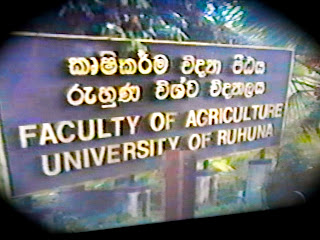So U of R is one of 15 public universities and everyone here knows it well. Ruhuna means the southern area in fact. Public universities are funded by the government and the cost is cheaper for students but they are extremely difficult to get in. You have to "sit for the A level exam" and get high scores (in high school). If you don't have the scores, you would have to go to a private university and this is very expensive. The result is a small percentage of people go to university in Sri Lanka. This is a contrast to the very high percentage of literacy for Lankans, 98%, and the high number who complete high school.
https://en.m.wikipedia.org/wiki/Education_in_Sri_LankaThere are many campuses; the one I was assigned to was this one in the deep south in a rural area. Well, you will see why...(I was first one assigned to Niyagama College near Elpitiya, also in the south, but the students went on an extended strike so I was reassigned here.)
LATER:
We took a regular public bus to Matara, about 1 1/2 hrs past gorgeous, rough beaches (the waves are crashing)...the buses are quite the same, religious adornments on the dash, sometimes old curtains, open windows, no AC, loud Lankan music and frequent honking. (Thus Yvonne figured out why the Lonely Planet recommends earplugs, ha ha.) We arrived by 3 wheeler from Matara (30 more min-I found out the road is recently paved and it's a faster commute to the campus) about 3pm.
OMG, a flood of memories, like goosebumps, spread all over me. The guy in the security office checked me out, as he does all visitors, the walk across the bridge-like entrance that has water and rice paddy on each side...students and guys on bicycles passing me in their sarongs and saris, keen to know who I am. The lush, THICK jungle on all sides. So peaceful, rural...my former home.
At the "new security office" near the BQ houses, I asked the guy if he remembered me. I told him I lived there 20 years ago. Then he said, "you were fat and had a bicycle?" I said, "Yes, ha ha. That was me!!" We both looked at each other, it clicked, we remembered each other. It was a remarkable moment that words cannot describe.
I always loved walking around the grounds and talking to the people who keep it beautiful. They are always so excited when I greet them, and they seem very content with their jobs.
We sat in Champa's office, chatted, had tea, and discussed plans. Champa described me as "her teacher" that taught her so many things. Her career really took off about that time. She became assistant professor, then got her PHD and became professor of Agro-Science.
A woman came to greet us named Sumana. She remembered me very well, but she told me I spoke lots of Sinhala before (implying now It took awhile for me to remember...as a side job she cooks for some of the professors and makes them lunch packets. I am sure she made some of mine. (I realized I rarely ate in the canteen, so I must have cooked myself or received lunch packets.) It did make it difficult to talk with some people due to my struggle to find the words. Slowly I was gaining some daily conversation skills though.
Champa explained that now there are 3 batches of students accepted each year:
Agricultural Resources Management Technology (about 150 students)
Green Technology (50 students)
Agri-business management (50 students)
When I taught at the faculty, there was only the first "major".
Also, when I was there, there were only about 125 students. As a result, they have had to build a large dormitory that was first intended for 2 students per room, but now they will accommodate 4 per room. It is really nice. They also had a kind of drought here, so during the term of Mr. Subasinghe, they dammed up what used to be rice paddy and made ponds to shore up more water.
My lovely former coworker, student and friend, Sandya Subasinghe, the librarian.
Sandya showed us around a lot. We first got a tour of the library; it is quite a large library with both Sinhala, English and other languages. Now it has a computer room. (We also saw three large computer labs.) They have an online catalog system, for the last 15 years or so. You can reserve a book this way. The library was designed to utilize natural lighting with its high ceilings. During the day, one does not even need lights. And it is so cool inside, without fans really even. Her and her husband, now the Dean also had us over for a grand dinner our first night.
We slept in the Guest House on campus. That was exactly what I wanted, to relive campus life. We heard and saw peacocks, "me-ow, me-oww!"
Sandya took us to see the livestock too, the chicken coops with white and brown chickens, the water buffalo and cows feeding at the trough, and the highlight was seeing these two humongous pigs, mama, papa and piglets. They were a special breed, big, beautiful and noisy.
These are administrative staff, and the person on the left,Prasanthika, was also a former student.
PERAHERA!






No comments:
Post a Comment